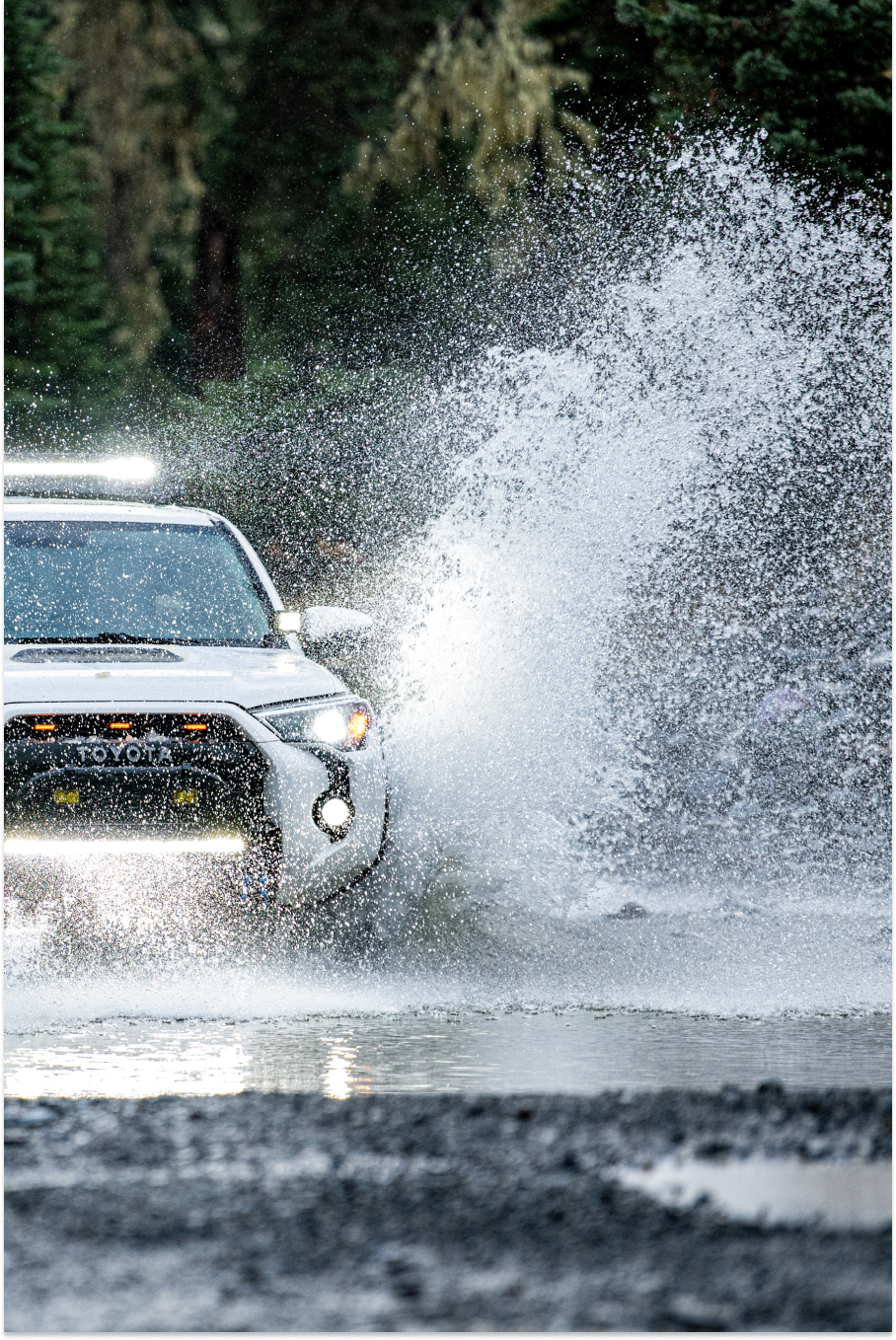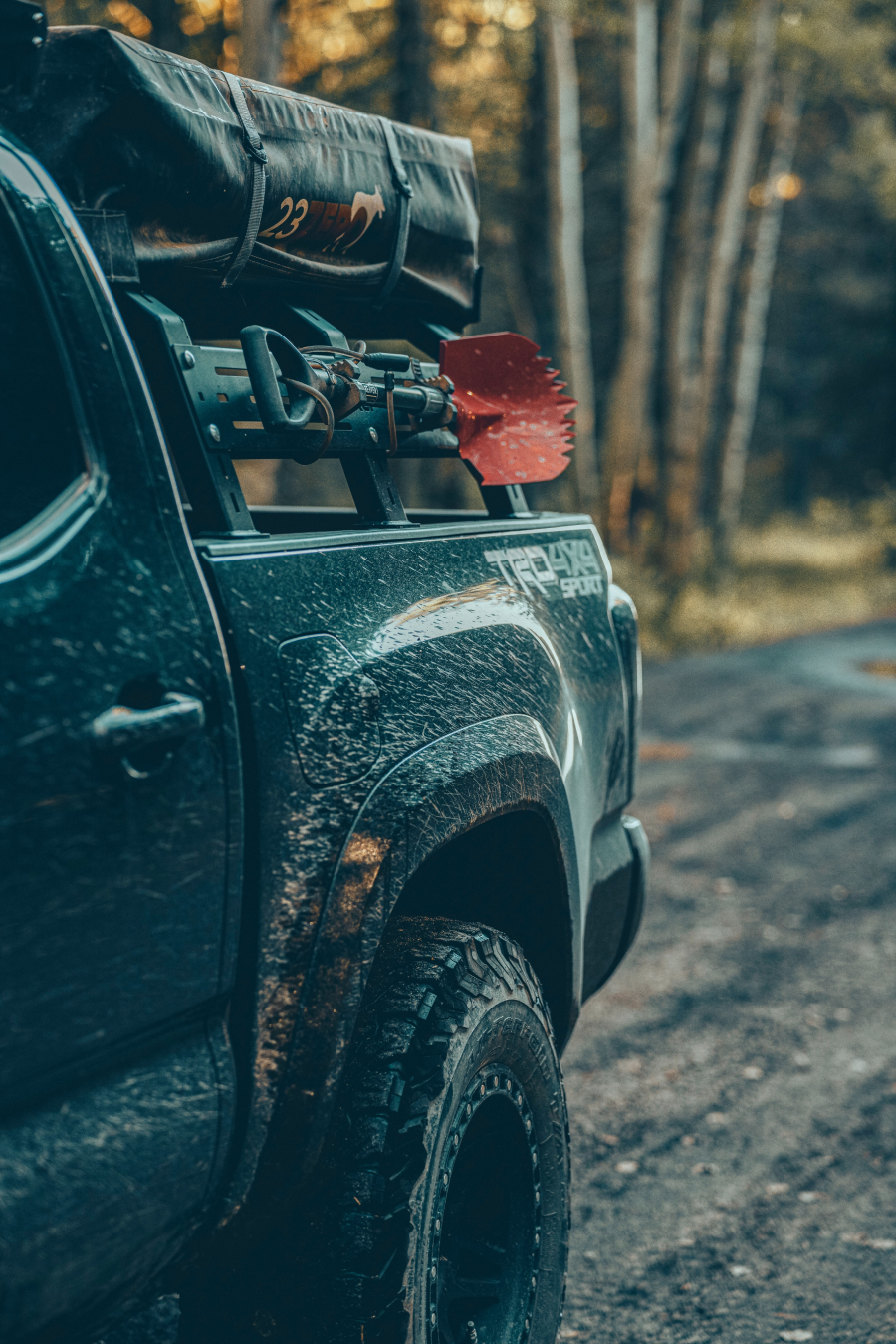How to Find Free Camping Near Me
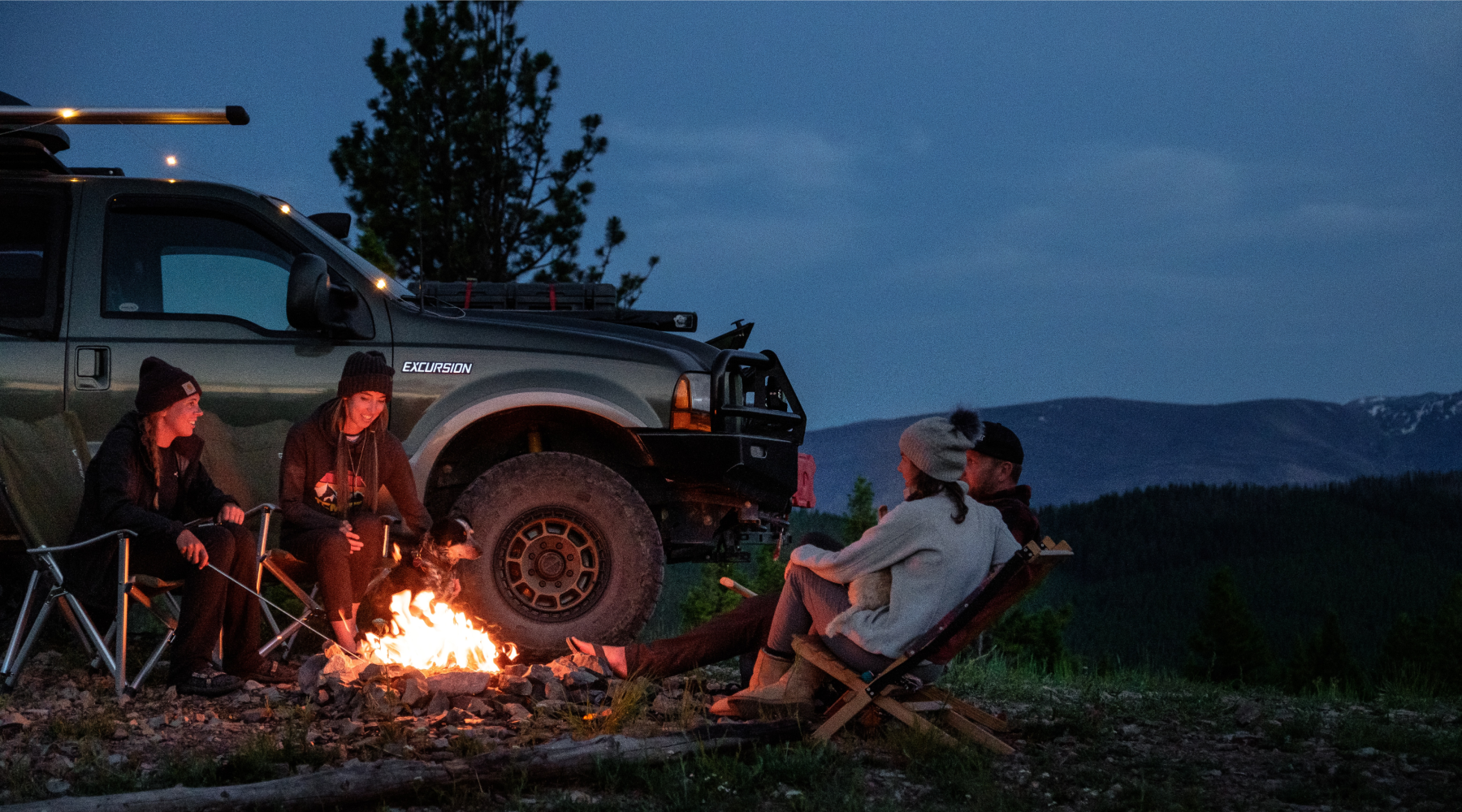
Free campsites are a dime a dozen in the United States. It’s finding them that’s the trick. Let’s learn how!
Camping is all about freedom and experiencing the wilderness… So why all the various camping fees and permits? It’s rough out there. Sometimes securing a campsite at a popular campground can feel as hard as winning the lottery. (This isn’t just a figure of speech. Crowded campgrounds often use lottery systems in high season, which means securing a campsite comes down to a coin toss.)
If you’re fed up with all of that and wondering, “How do I find free camping near me?” don’t worry. You’re not alone. Thanks to organizations like the Bureau of Land Management (BLM), U.S. Forest Service (USFS), and of course, the National Park Service (NPS), there’s plenty of free camping across the United States. With a few tips and tricks, it’s possible to find free campsites just about anywhere, and you’ll steer clear of all the crowds in the process. Let’s learn more.
Three Tools to Find Free Camping
For starters, we’ll discuss a few tools you can use to find free camping near you, whether you’re searching for RV boondocking, dispersed tent camping, or established free or permit-only campsites. The following are the three most reliable and effective services to find free camping around the United States, though there are plenty of other sources out there as well. iOverlander and FreeRoam are two other excellent options not listed here.
Free Campsites
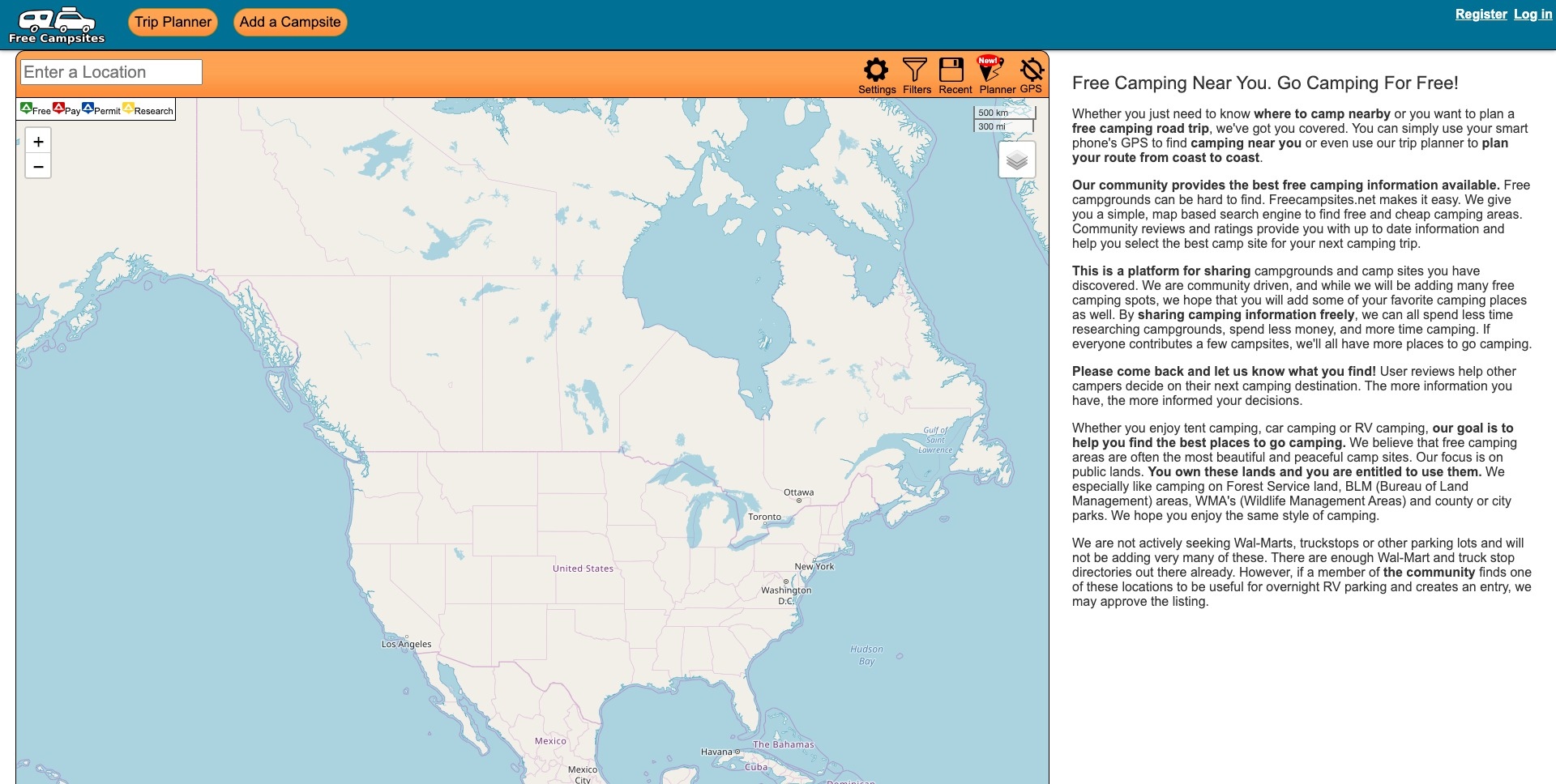
Free Campsites is the best tool for free camping in the United States, with thousands of free campsites nationwide. I’ve used this site for around ten years, and it’s never let me down. Simply type in a location, and the tool will share campsites in the vicinity, both via map and a traditional list.
Free Campsites focuses on helping you find free, dispersed camping areas (indicated by green tent icons) , usually tent camping on Forest Service land, BLM areas, Wildlife Management Areas, and county or city parks. However, it also shares paid and permit-required sites, indicated by red and blue tent icons, respectively.
Once you select a site, you’ll see GPS coordinates, elevation, a 5-day weather forecast, cell phone coverage reports, a brief summary of the site, and photos and reviews from other campers. Be cautious though, many of the sites here are old and sometimes haven’t been updated in years. Unless you find a site with recent reviews, it's a bit of a toss-up. While I use the web version, Free Campsites also has an app available on Google Play, though not the App Store (iOS).
The Dyrt

If you’re looking for something with a bit more production value, The Dyrt is an excellent alternative to Free Campsites. The site works quite similarly to Free Campsites, with an interactive map and campsite lists by city, state, and popular national parks. All the same features available on Free Campsites are here, and the overall UX here is much more intuitive and easy to use.
The major downside to The Dyrt is that a paid “PRO” membership ($35.99/year) is required to access free campsites. Once you’re a member, you’ll access the “Free Camping Collection,” which collects all drive-in accessible free dispersed campsites (boondocking), free campgrounds, free overnight parking (established), and free camping areas (public lands like the national Forest Service, and BLM)—for a total of 5,000 free campsites—in addition to unlocking curated permit information for free and paid campsites.
The PRO membership also allows for offline map backups and offline search, discounts on paid sites, and additional trip planning tools. They offer a free trial, which may be a good way to find out if the advantages are worth the subscription cost. The Dyrt has an app on both Google Play and the iOS App Store.
Campendium
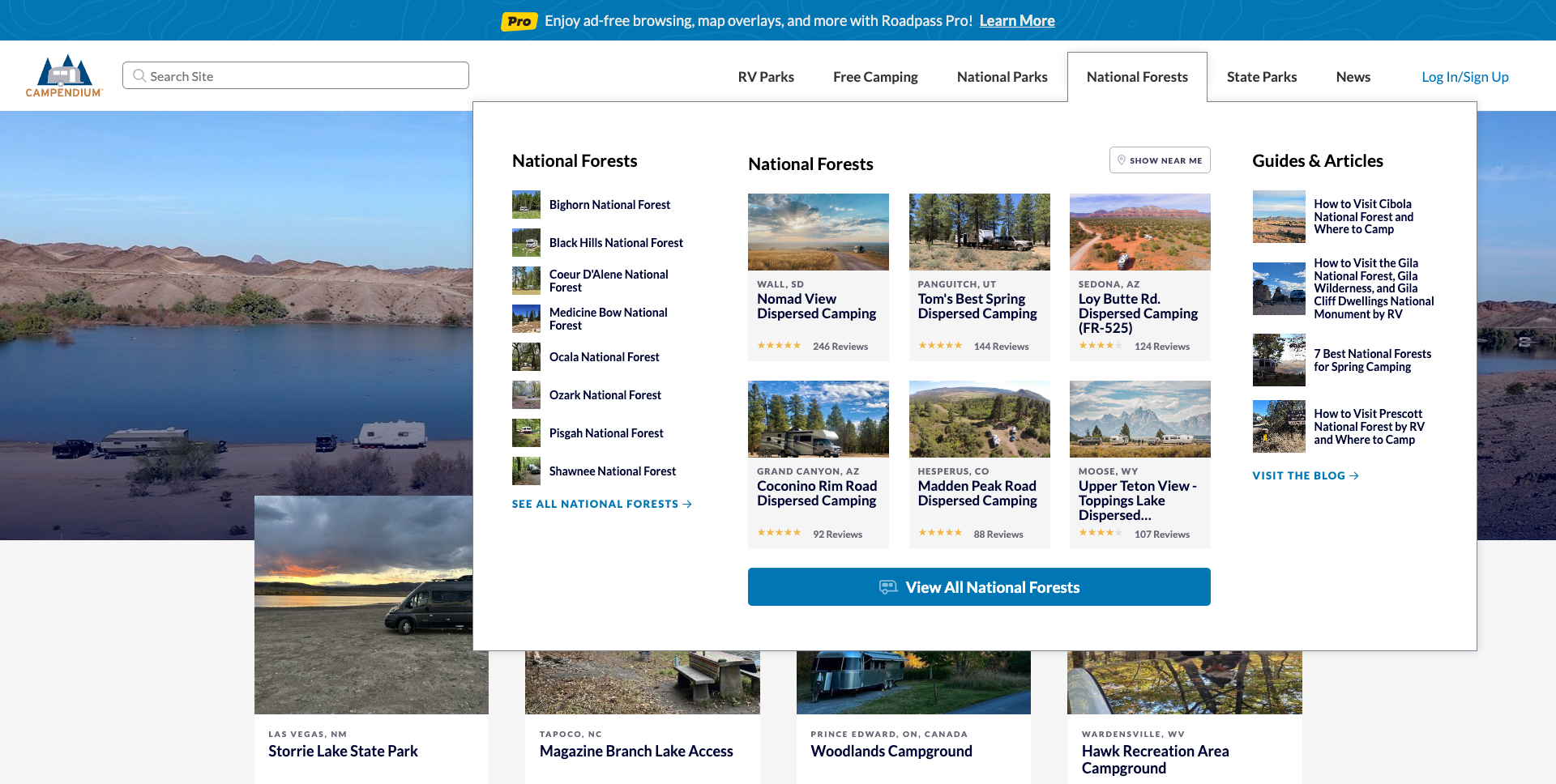
Campendium is another reliable site for free camping, with a very nice layout and intuitive search system similar to The Dyrt. This site primarily focuses on RV camping, but also offers a “Free Camping” segment with nearly 3,000 free sites across the United States and Canada.
Campendium hawks a subscription-based service, Roadpass Pro, but it’s not required to access free camping. This subscription does have a few advantages of course, including removing all ads, adding cell service overlays and reports (which you can already get for free on Free Campsites), public land map overlays, trail maps, and a filter to find campsites by elevation. Campendium has an app on both Google Play and the iOS App Store.
Unveiling Hidden Camping Gems: Lesser-Known Resources
When it comes to unearthing hidden camping spots that are free, sometimes digging a little deeper into lesser-known resources can yield great rewards. Here are some of those gems:
Local Forums and Community Boards
Local online forums and community boards often have threads where individuals share their favorite camping spots. Platforms like Nextdoor or regional Reddit forums could be a goldmine for discovering local free camping options.Furthermore, specialized forums such as those on backpacking or outdoor adventure websites often have dedicated sections for sharing camping spot recommendations. Users in these forums are usually seasoned campers and can provide valuable insights on lesser-known camping spots along with tips on how to access and camp in these areas responsibly.
Social Media Groups
There are numerous social media groups, especially on platforms like Facebook, where camping enthusiasts share their experiences. Joining local camping groups and participating in discussions can lead you to discover some off-the-beaten-path free camping spots.
Instagram is another platform where campers share their experiences. By following certain hashtags like #freecamping, #wildcamping, or #boondocking, you can discover posts from individuals who have explored hidden camping spots. They often share the location and their experiences which could be a treasure trove of information for someone looking to explore new camping spots.
Word of Mouth
Sometimes, the old-fashioned way is the best way. Engaging with local camping communities, visiting local outdoor gear shops, or simply striking up a conversation with a fellow camper could lead you to some of the best free camping spots around.
Local outdoor adventure clubs and meetups are also great places to gather word-of-mouth recommendations for lesser-known camping spots. These communities are often filled with like-minded individuals who have explored the local area extensively and are willing to share their knowledge.
Geocaching Websites

Geocaching is a recreational activity involving participants using GPS devices to hide and seek containers, called "geocaches" or "caches", at specific locations marked by coordinates worldwide. Geocaching websites often have forums where participants discuss places, which could include discussions on camp for free camping spots.
In addition to forums, geocaching events are great opportunities to meet local outdoor enthusiasts who are familiar with the area. They can provide recommendations for secluded camping spots that are not well-known or heavily trafficked. Moreover, the geocaching community is built around exploration and discovery, aligning well with the spirit of uncovering hidden camping gems.
How to Stay Safe When Free Camping
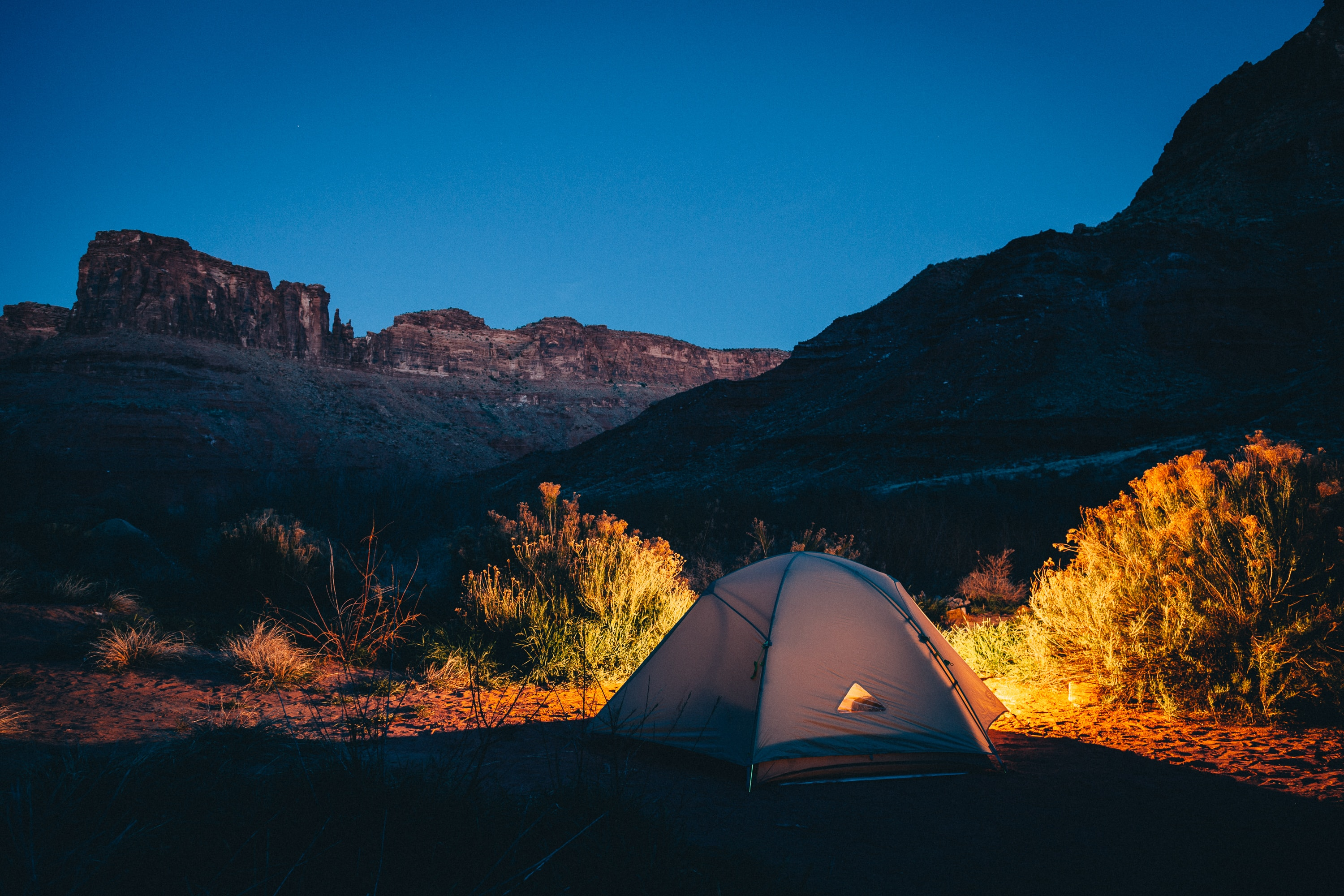
Safety is a concern anytime you’re camping—you’ll deal with hazards from weather to wild animals—but this is especially true when you’re camping for free. That’s because free camping means all-comers. Free campsites are often in remote areas and usually unmonitored, with no site manager or other staff. When free camping, you need to take care of yourself.
The vast majority of free campsites are very safe and mellow, but there are always bad eggs. When free camping, you may run into drugs and alcohol, guns, fireworks, and more. Reading recent site reviews and looking at photographs is the best way to be prepared. Still, particularly on user-supported sites like Free Campsites, there is sometimes campsite info that’s extremely out of date.
That said, don’t worry too much. I’ve been free camping for a decade now and have never had an unsafe experience, but I also do my research, and I’m not afraid to pack up and move sites if I feel unsafe. Be sure to pack a cell phone or another communication device and research cell coverage in advance. (This information is available on all the free campsite tools I listed above.) It’s also advisable to carry some form of defensive weapon, such as mace, a taser, or a firearm, to protect yourself in the wilderness. Also, always tell someone your camping plans and expected return date.
Of course, you should also practice all basic safety procedures for camping. Be aware of weather conditions, wildlife, fire restrictions, and local hazards. Carry appropriate gear and first aid supplies.
Navigating Remote Locations Safely
GPS and Offline Maps
Ensure you have a reliable GPS device and download offline maps of the area you plan to camp in. Services like Google Maps or Mapbox allow for offline map downloads.
Emergency Communication Devices
In remote areas, cell service can be nonexistent. Having an emergency communication device like a satellite phone or a personal locator beacon (PLB) can be a lifesaver in case of emergencies.
Local Knowledge
Before heading out, it's wise to speak with locals or visit nearby ranger stations to gather information on current road conditions, wildlife activity, and other essential details that can affect your camping experience.
Help Keep Free Camping Free
Free camping is a privilege, not a right, and it’s up to us to be responsible stewards of the land so that we can keep as much of America’s camping free as possible. Free camping on public lands offers a unique opportunity to connect with nature and experience the beauty of the wilderness, and that won’t last if we don’t do our best to leave wild spaces as we found them.
While camping, always follow Leave No Trace principles, such as packing out all trash, minimizing your impact on the environment, and respecting wildlife. Remember that but it also comes with the responsibility of being a good steward of the land.
Look for established campsites if available, instead of clearing a new campsite, to minimize environmental impacts. Also, camp at least 200 feet away from water sources to protect water quality and wildlife habitats.
Follow rules and regulations for the site, particularly with regards to campfires. Due to climate change, wildfires are increasingly common and destructive. Campfires may be restricted in some areas, especially during dry or fire-prone seasons. Always use established fire rings if available, keep fires small and manageable, and monitor them at all times, ensuring the ashes are cool to the touch before you leave the site.
Eco-Friendly Camping Practices
Adhering to eco-friendly camping practices is not only beneficial for the environment but also ensures the longevity of free camping spots. Here are some green camping tips:
Minimize Waste
Pack food in reusable containers, use a refillable water bottle, and avoid using disposable plates and utensils. Minimizing waste goes a long way in preserving the natural beauty of camping spots.
Use Eco-Friendly Products
Opt for biodegradable soaps and detergents, and avoid using harmful chemicals that can contaminate water sources.
Wildlife-Friendly Camping
Ensure your camping activities do not disturb the local wildlife. Maintain a safe distance, and avoid feeding animals or leaving food scraps around.
Tech Gear for Modern Campers
In today's digital age, camping has embraced modern technology to make the experience safer and more comfortable. Here are some tech gears that could be useful:
Solar Chargers
Solar chargers are a fantastic way to keep your devices charged while camping. They are eco-friendly and ensure you stay connected even in remote areas.
Portable WiFi Hotspots
If you're planning a long-term camping road trip somewhere, a portable WiFi hotspot can be invaluable. It provides internet access, ensuring you stay connected with the outside world.
Weather Apps
Weather apps with reliable forecasts are crucial for planning your camping trips. Apps like Weather Underground or AccuWeather provide detailed weather forecasts to help you prepare for your adventure.
Exploring Nearby Attractions
One of the joys of camping is exploring the great outdoors. Consider researching nearby natural attractions, hiking trails, lakes, rivers, the many national parks and forests, and local events or festivals. Engage in activities like fishing, birdwatching, or star gazing to enrich your camping experience.
Community Engagement
Joining clean-up crews or participating in local conservation efforts can be a rewarding experience. Not only does it contribute to keeping camping spots pristine, but it also fosters a sense of community among campers.
Seasonal Considerations
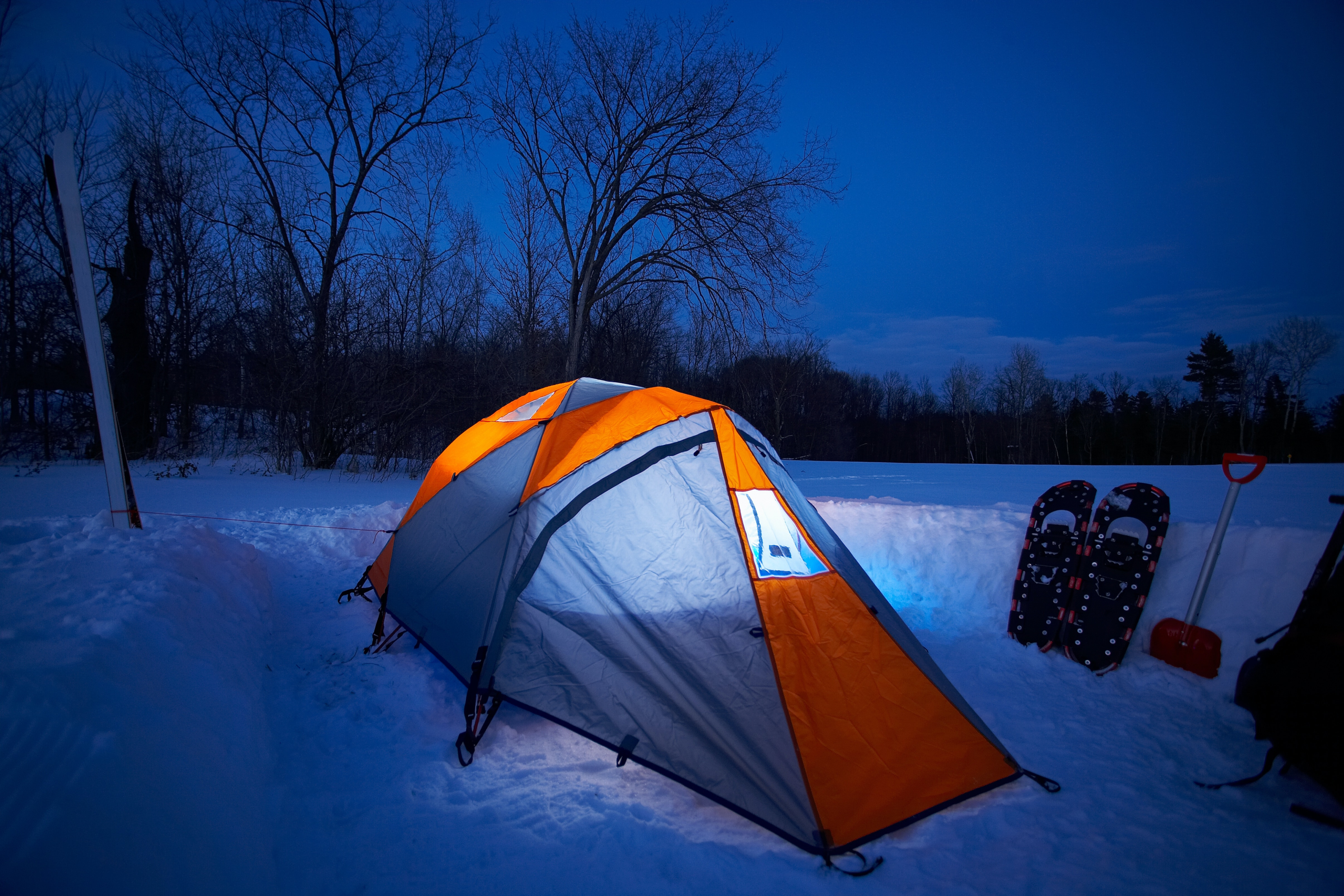
Each season brings a unique camping experience. Explore the pros and cons of camping during different times of the year, from the lush scenery of spring to the dry camping and the serene snow-covered landscapes in winter.
Local Laws and Regulations
Understanding local laws and regulations regarding camping, fires, and wildlife interactions is crucial. Ensure you're compliant to avoid fines or other legal issues.
Preparing for Emergencies
Having a basic first aid kit, knowing the nearest medical facilities, and learning basic first aid skills can be lifesaving in case of emergencies. Consider taking a wilderness first aid course to better prepare for unexpected situations.
Photography and Journaling
Documenting your camping experiences through photography or journaling can be a fun and reflective activity. Share your stories and photos with friends, family, or the online community to inspire others.
Tips for Free Camping
Research and Plan
As I mentioned above, before you set out for any destination it’s important to check for specific rules and regulations, as they will vary by county, state, and region. Sites like Free Campsites won’t always have the most up-to-date info, so check several sources before you leave home. Some areas may have restrictions on camping near water sources, campfires, or maximum stay durations.
Additionally, considering the timing of your camping trip is crucial. Being aware of the peak camping seasons and planning your trip during the off-peak times can lead to a more peaceful camping experience with less competition for spaces. Further, understanding the local wildlife and their active seasons can help ensure a safer camping experience.
Water and Sanitation
Oftentimes free camping sites lack potable water, so ensure you have enough water for your trip. Otherwise, bring a water pump or other purification method and check maps for nearby water sources.
Also, handle human waste responsibly by carrying a portable toilet or digging a “cathole” and following proper disposal guidelines (typically 6-8 inches deep at least 200 feet from water, camp, and trails).
Consider carrying hand sanitizers and eco-friendly soap to maintain hygiene while reducing your environmental impact. It’s also a good practice to carry a small shovel or trowel to cover up human waste properly.
Camping Equipment
Particularly if you’re car or RV camping, carrying compact or lightweight gear isn’t that important. You probably have space for a bit of luxury. But using lightweight, low-impact camping gear will always make it easier to camp in remote areas. It’s also a good way to reduce your environmental footprint. If you’re tent camping and traveling on foot or bicycle, then lightweight and compact gear is absolutely crucial.
Invest in a good quality tent, sleeping bag, and sleeping pad to ensure comfort and protection against the elements. Multi-purpose tools and gear can also save space and reduce the amount you have to carry.
Wildlife
Wildlife is present in almost all free campsites, whether small scavengers like squirrels and racoons to potential threats like bears and coyotes. Store food securely to prevent wildlife encounters. Even larger animals like bears rarely attack humans, but they are attracted to improperly stored food or other smellables, like toothpaste, deodorant, and scented lotion. Use a bear bag, canister, or fixed bear box and store it away from your campsite to avoid attracting any unwanted visitors.
Understanding the wildlife in the area you are camping in is crucial. Research and get knowledge about the local wildlife, their habits, and how to react in case of an encounter. Carrying wildlife deterrents like bear spray and making noise while hiking can help avoid unwanted wildlife interactions.
NOTE: Storing smellables inside your car is NOT the answer. Wild animals, particularly bears, regularly break into cars to get at stored food.
Respect Local Communities
It’s not just about respecting wildlife. Humans may live nearby, as well, and if free camping in their area becomes a problem, they’ll likely lobby to shut the site down. Always be courteous to nearby residents and communities. Keep noise levels down, respect private property boundaries, and pack out whatever you pack in. Leave nature as you found it.
Engaging with local communities can also lead to discovering lesser-known camping spots and gaining valuable insights about the area. Always adhere to local customs and traditions to maintain a respectful and harmonious relationship.
Be Flexible
This is the most important thing to know about free camping. You have to be flexible! You won’t have a reservation to secure your spot. The vast majority of free campsites are first come, first serve. Popular free camping spots can fill up quickly, so it’s crucial to have a backup plan in case your first choice is occupied.
Other campers aren’t the only factor that can scuttle your free camping plans. Your site could be flooded, littered with trash, destroyed by a mudslide or wildfire, or no longer “free” at all. (Check current regulations before you head out!) So stay relaxed, be prepared for the unexpected, and have a few backup sites in case you arrive at your chosen site and for whatever reason you find it’s unsuitable.
Also, being open to changing locations or plans ensures a stress-free camping experience. Sometimes, the best adventures are unplanned, and being flexible allows you to embrace the unexpected joys of free camping.
Looking for free camping in California, Moab or Sedona? Check our our other blog posts for tips and locations.
About the Author:
 Owen Clarke is an action sports and adventure travel journalist living on the road. His primary focus is rock climbing and mountaineering, but his work appears in over 50 international magazines covering a variety of niches. In addition to vertical sports, he also has a penchant for motorcycles and long-distance trekking.
Owen Clarke is an action sports and adventure travel journalist living on the road. His primary focus is rock climbing and mountaineering, but his work appears in over 50 international magazines covering a variety of niches. In addition to vertical sports, he also has a penchant for motorcycles and long-distance trekking.




